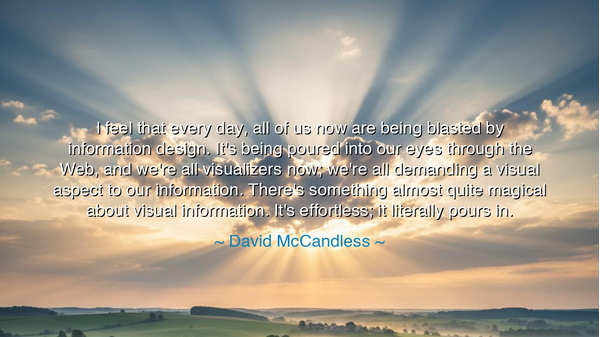
I feel that every day, all of us now are being blasted by
I feel that every day, all of us now are being blasted by information design. It's being poured into our eyes through the Web, and we're all visualizers now; we're all demanding a visual aspect to our information. There's something almost quite magical about visual information. It's effortless; it literally pours in.






Hear, O seeker of truth in the age of light and shadow, the words of David McCandless, master of information design and cartographer of modern knowledge, who proclaimed: “I feel that every day, all of us now are being blasted by information design. It’s being poured into our eyes through the Web, and we’re all visualizers now; we’re all demanding a visual aspect to our information. There’s something almost quite magical about visual information. It’s effortless; it literally pours in.” In these words lies both wonder and warning — a revelation of the power of images, and a reminder of the responsibility they bring. For McCandless, who shaped data into beauty, saw that in our age, sight has become the new language of understanding, and that humanity now dwells within a flood of visual knowledge.
David McCandless, born in Britain, rose to prominence as a journalist and designer in the early 21st century, an era defined by the explosion of digital media. His works, such as Information Is Beautiful and Knowledge Is Beautiful, transformed numbers into stories, and statistics into art. In his quote, he captures a profound transformation of human consciousness — that the eye, once a passive witness, has become the chief interpreter of truth. No longer do we merely read words; we see meaning. The Web, that endless river of images, graphs, and patterns, has made every person not just a consumer of information, but a visualizer, one who seeks to grasp reality through the geometry of design.
But in his vision there is also awe — the recognition of something magical in this new way of knowing. He speaks of visual information as “effortless,” as though it flows directly into the soul without resistance. For in ancient times, the storyteller spoke to the ear, painting images with language; today, the designer speaks to the eye, bypassing the labor of words. The ancients drew myths upon cave walls, carved tales in stone, wove symbols into the fabric of faith. Now, the same instinct manifests through glowing screens and living colors. McCandless thus joins the lineage of the storyteller, reborn in a digital age, shaping meaning from chaos with the tools of design.
Yet, O listener, his words are not only praise but prophecy. For if information pours into us so freely, if it “literally pours in,” we must beware the danger of overwhelming abundance. What is effortless can also be unexamined. When the eye is flooded, the mind can grow numb. The magic that McCandless describes is a double-edged gift — it enlightens, but it can also bewitch. The ancient philosophers warned of this long ago: Plato spoke of shadows on the wall, of men mistaking images for truth. So too must we guard our sight in this modern cave of glowing screens. The flood of design can illuminate reality — or drown it in illusion.
Consider the example of the Apollo 8 photograph of Earth, known as Earthrise. In 1968, astronauts captured an image of our blue planet rising above the gray lunar horizon. That single visual moment, wordless and pure, transformed human consciousness. It made billions understand, in an instant, the fragility and unity of life upon the Earth. Here lies the truth McCandless names as “magical” — that an image can compress the infinite into an instant, can do what words alone struggle to achieve. Yet that same power, when misused, can manipulate rather than enlighten. The weaponization of images, the distortion of design for persuasion, shows that beauty, too, can be wielded as a tool of deception.
McCandless’s insight, therefore, is both celebration and summons. He teaches that we are all now creators, not merely receivers. Every chart we share, every photo we post, every color and shape we choose — these are acts of communication, shaping how others see the world. We are no longer passive; we are participants in the visual chorus of humanity. To live wisely in this new age is to wield the eye with integrity — to craft clarity instead of confusion, to use design not for vanity, but for truth.
So take this lesson into your heart, O child of the digital dawn: the eye is your gateway, but discernment must be your guard. Do not allow the flood of images to dull your perception. Seek always the meaning behind the design, the soul behind the spectacle. Let your own creations, whether word or picture, serve beauty and understanding. For as McCandless reminds us, the visual is not mere ornament — it is the new language of the world, as ancient in spirit as the first fire-lit stories on the cave wall, and as new as the light of your screen.
And when next you gaze upon the flood of colors, charts, and shapes that pour into your sight, remember the sacred charge within them: that to see is to know, and to know is to act. Let your seeing, then, be mindful, reverent, and true — so that the magic which “pours in” may become not a deluge of distraction, but a river of wisdom flowing toward the future.






AAdministratorAdministrator
Welcome, honored guests. Please leave a comment, we will respond soon